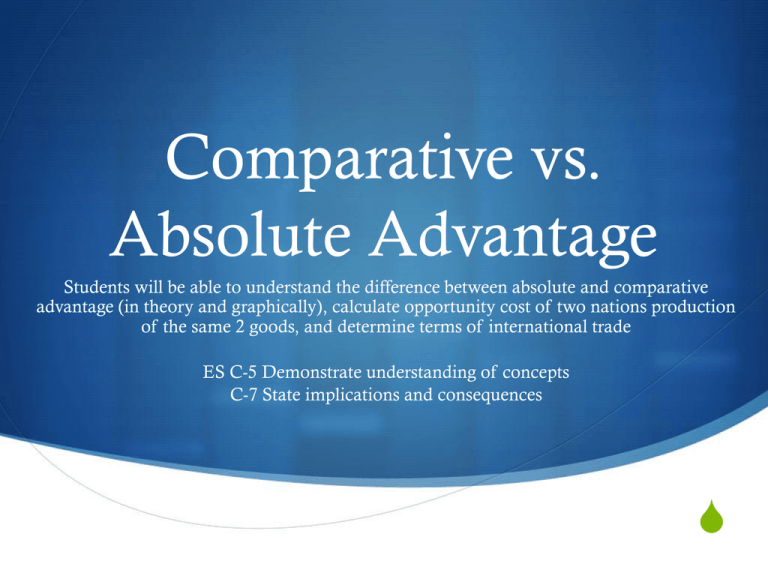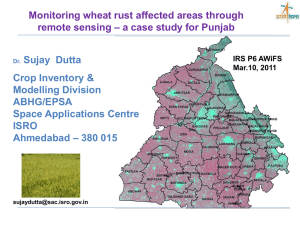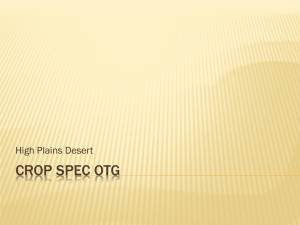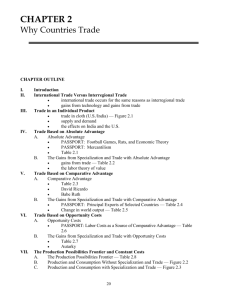Comparative vs. Absolute Advantage
advertisement

Comparative vs. Absolute Advantage Students will be able to understand the difference between absolute and comparative advantage (in theory and graphically), calculate opportunity cost of two nations production of the same 2 goods, and determine terms of international trade ES C-5 Demonstrate understanding of concepts C-7 State implications and consequences S Absolute vs. Comparative Advantage S Absolute Advantage: S Either: A) a individual/firm/country can can produce more of a good with the same input as another country S B) Can produce a certain output using a fewer amount of resources as another (mainly illustrated in terms of time) S LEBRON HAS ABSOLUTE ADVANTAGE IN MOWING HIS LAWN! S Comparative Advantage: S Whoever can produce a good with a lower opportunity cost!!! S More influential in production than absolute advantage! S FELIX HAS COMPARATIVE ADVANTAGE IN MOWING LEBRON”S LAWN! Result of Specialization S Production of “Widgets” demonstration S Why don’t we all make our own houses, grow/gather our own food, heal our own wounds? S Trade S Increases our standard of living…we assume S Specialization—the division of tasks which leads to gains from trade (me and you, or entire world economy) Adam Smith Says: S In 1776s The Wealth of Nations Smith describes what you just witnessed S 18th century pin factory, where rather than 10 workers making a pin from start to finish, each worker should specialize in one of the tasks in completing one pin… S “those 10 persons, therefore, could make among them upwards of forty-eight thousand pins in a day. But, if they had all wrought separately and independently…they certainly could not each of them have made twenty.” Why Comparative Advantage is Key S Suppose that an American worker can produce 50 shirts or 200 bushels of wheat per day. A Chinese worker can produce only 25 shirts or 50 bushels of wheat. S The U.S. has an absolute advantage in shirt production since a U.S. worker can produce more shirts than a Chinese worker. S The U.S. has an absolute advantage in wheat production since a U.S. worker can produce more wheat than a Chinese worker. S Issue to resolve: Does it pay for the U.S to trade with China? Why Comparative Advantage is Key S To understand how each country decides which good to produce when they interact, we calculate opportunity cost: S U.S.: 1 shirt costs 4 bushels of wheat—1 wheat costs ¼ shirt S China: 1 shirt costs 2 bushels of wheat –1 wheat costs ½ shirt S Therefore, China should specialize in shirts and the U.S. in wheat. Absolute and Comparative Advantage Illustrated S Which is which? S Country B—Absolute in both S Country A—Comparative in car production Input Model S Told about what resources are needed to produce one unit of a good in order to calculate opportunity cost. S S “…required to produce…” “…per hour…” S Input model--- number goes “under” Output Model S Given final data on the amount of a good that can be produced with a given amount of input to calculate opportunity cost. S Output model---number goes “over” Gains From Trade Suppose the U.S. has 150 million workers and China 800 million. Without trade, each nation produces and consumes on their own based on their preferences. Let us assume the U.S. produces 5 billion shirts and 10 billion wheat. Let us assume China produces 10 billion shirts and 20 billion wheat. Alone, they are inefficient because… When specialized, producing the good they have a comparative advantage in total production increases. See below… Gains From Trade Terms of Trade S We can use all the information we can now calculate to determine a fair “price” for different producers to seek when trading. Use their opportunity costs. S Keep in mind: There is room for trade as long as the two countries differ in their opportunity costs to produce a good and they set a “trading price” that falls between those opportunity costs. Terms of Trade S After specialization, assume the two countries agree to trade 20 billion bushels of wheat for 7.5 billion T-shirts. Are the outcomes going to be an improvement for both countries? S In our example from yesterday, S S U.S.: 1 shirt costs 4 bushels of wheat—1 wheat costs ¼ shirt China: 1 shirt costs 2 bushels of wheat –1 wheat costs ½ shirt So, S the price at which China and the U.S are willing to trade T-shirts must fall between China’s opportunity cost for producing T-shirts and U.S.’s opportunity cost for producing T-shirts. S China is the country that specializes in T-shirts, and it cannot charge a price greater than the U.S.’s opportunity cost. S Conversely, China must receive a price that covers its opportunity costs for making T-shirts, or it will not be willing to trade. Terms of Trade S From our original example: US producing 200 wheat and 50 shirts, while China produces 50 wheat and 25 shirts… S US opportunity costs: 1 wheat costs ¼ shirt—1 shirt costs 4 wheat S China opportunity cost: 1 wheat costs ½ shirt—1 shirt costs 2 wheat; therefore, S USA (wheat): before trade, the opportunity cost of making a T-shirt in the U.S was 4 bushels of wheat. Thus USA has no incentive to trade unless USA can get 1 T-shirt from China for less than 4 bushels of their wheat production S CHINA (T-shirts): before trade, China’s opportunity cost of making 1 T-shirt was 2 bushels of wheat. Thus China will not be willing to trade their T-shirts for U.S.’s wheat unless they can receive more than 2 bushels of wheat in exchange for 1 of their T-shirts. S Thus the mutually beneficial terms of trade for 1 T-shirt (1T) is: S Terms of Trade for T-shirts: “ 2W < 1T < 4W ” Remember… S NO country has comparative advantage in everything and every country has comparative advantage in something… S This fact deems trade essential for “efficient” production S What is this interaction called? S What are its implications on the world and it’s people? S Economic Literacy Assignment #1








